Going back from the Topkapi Palace towards our hotel that day, we first went to see the mausoleum of Sultan Ahmed I who ruled at the very beginning of the 17th century and who died very young from typhoid (he was only 27 years of age). Two of his sons who were also sultans (Osman II and Murad IV) are buried here as well, and so are numerous other members of the family, a total of over 30 individuals.
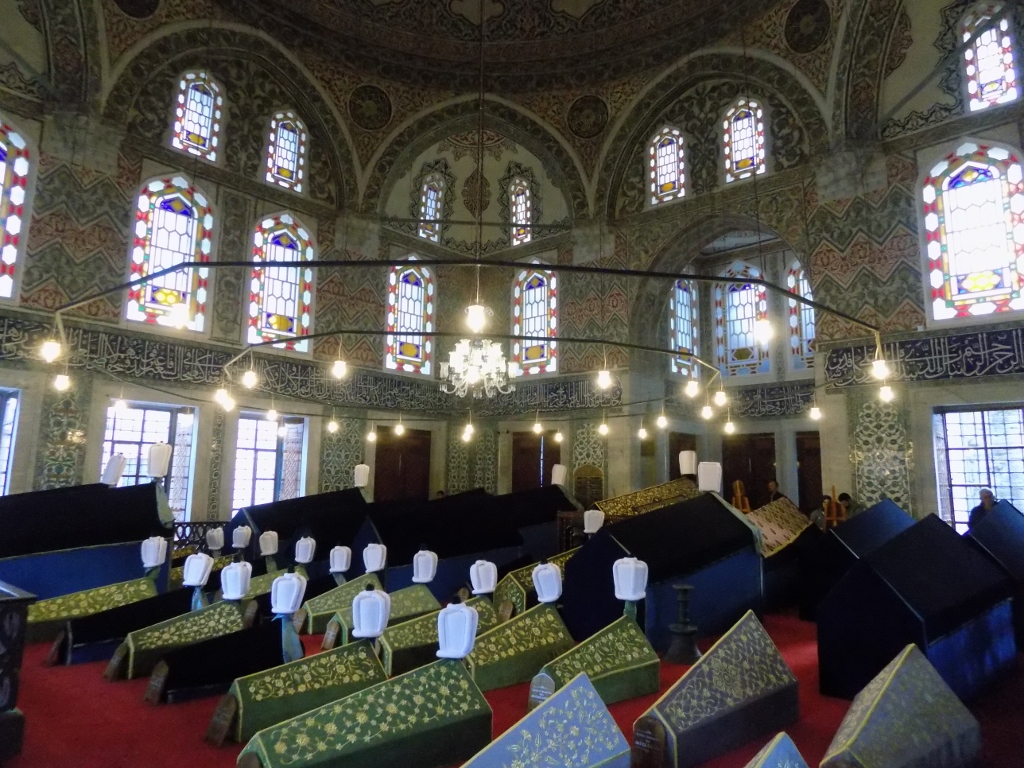 Sepulchre of sultan Ahmed I
Sepulchre of sultan Ahmed I
Almost throughout entire Istanbul there are bigger or smaller sepulchres-mausoleums (they are also called the türbe which means tomb) of rulers, their wives and children, as well as high officials and Ottoman noblemen – viziers, pashas, members of their families, etc. Each one of these edifices is often an architectural and decorative masterpiece and they certainly deserve to be visited. Perhaps not that one should start entering every single one of them, but from time to time, this is highly recommendable.
For instance, the Tomb of sultan Ahmed I was designed by the same architect who was in charge of the Sultan Ahmed Mosque, which is much better known by its other name – the Blue Mosque. That mosque is located on the same block as this sepulchre, i.e., vice versa – the tombs of the founders of mosques were most often built right next to the endowment (of course, if the founder had several mosques built, his tomb would, needless to say, be in only one place). So, after the tomb we just continued to the mosque, but before saying a few words about it, I just need to mention one other important thing which is linked to the Sultan Ahmed’s tomb.
This was the first place during our visit to Istanbul where we had to take our shoes off and cover our heads. This, of course, was no problem whatsoever for us and already back at home I packed up specifically for the purpose a long and wide cotton shawl (bought in Ajmer, India, in 2012 right when I was visiting the grave of a very important Sufi mystic and philosopher from the 13th century there – which was in many aspects a thoroughly enjoyable experience and hence I remember exactly such a trivial thing as buying that shawl for the occasion). I’m mentioning this for those who are not in the know – before entering a mosque or a tomb, it is necessary for people to take their shoes off, while women also need to cover their head, i.e., their hair by using a scarf or a shawl. The design for this purpose is in line with the personal choice. It goes without saying that one should not enter with their shoulders bare or in short skirts or in ordinary or Bermuda shorts. The Blue Mosque is still an active mosque (as opposed to Hagia Sophia) and therefore it is necessary to respect all the rules when visiting. If somebody does not like this, they should not visit places like this.
The mosque was built at the beginning of the 17th century. From the outside, one of its specific characteristics is the fact that it has six minarets, which is a relatively rare thing. Four minarets were built at the corners of the mosque, while two more were built at the corners of the courtyard. The reason why it got its other name are the hand-painted tiles used for the decoration of the mosque.
I have to say that I was rather disappointed when we entered the Blue Mosque, not with its beauty, of course, but simply because a large part of the interior was covered by protective curtains because of the ongoing restoration and that was the main reason why we no longer returned here, although we stayed at a hotel that was but a couple of minutes on foot away from the mosque. However, we did manage to see a little part of it and that was certainly impressive.
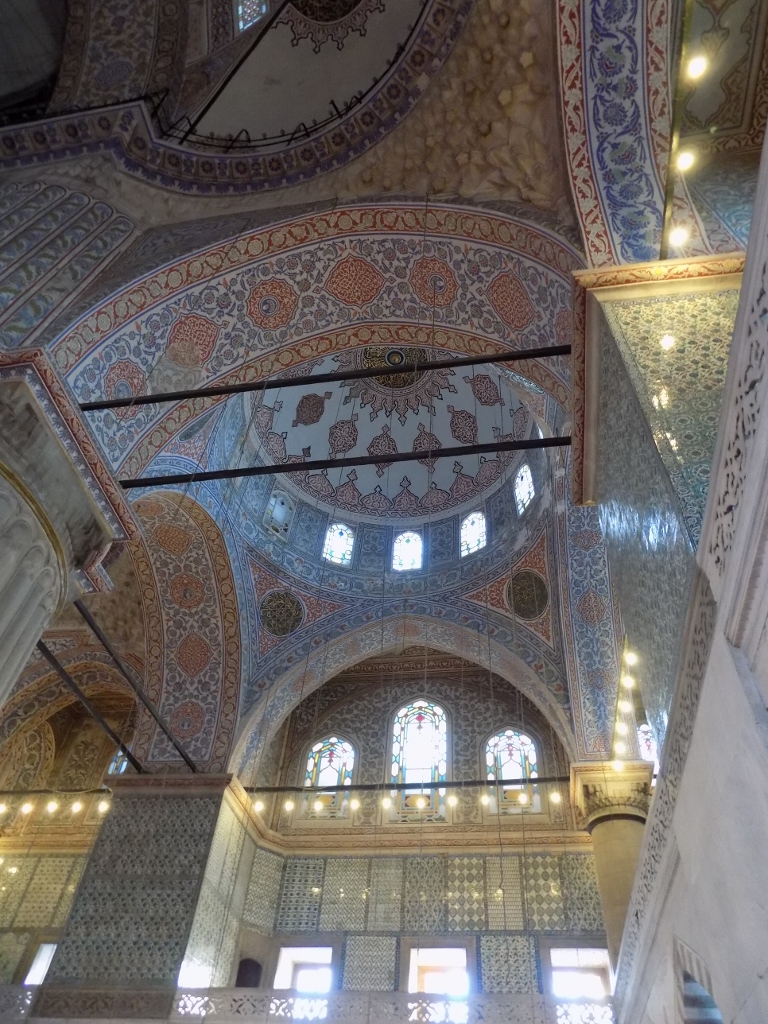 Blue Mosque, the interior
Blue Mosque, the interior
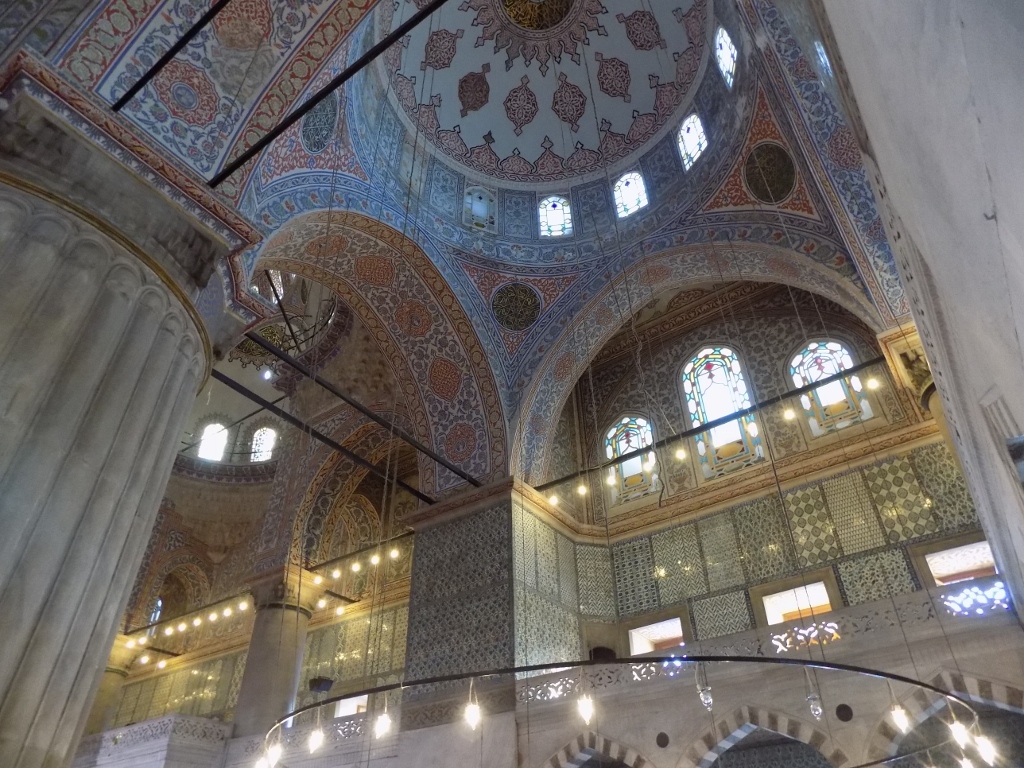 Blue Mosque, the interior
Blue Mosque, the interior
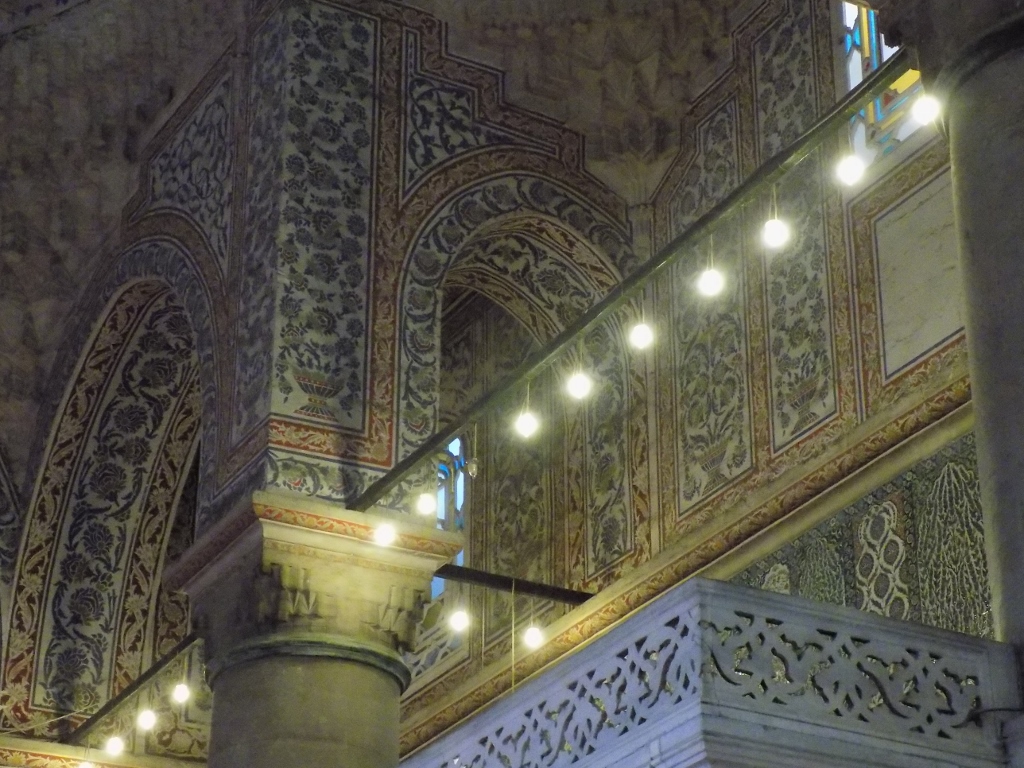 Blue Mosque, the interior
Blue Mosque, the interior
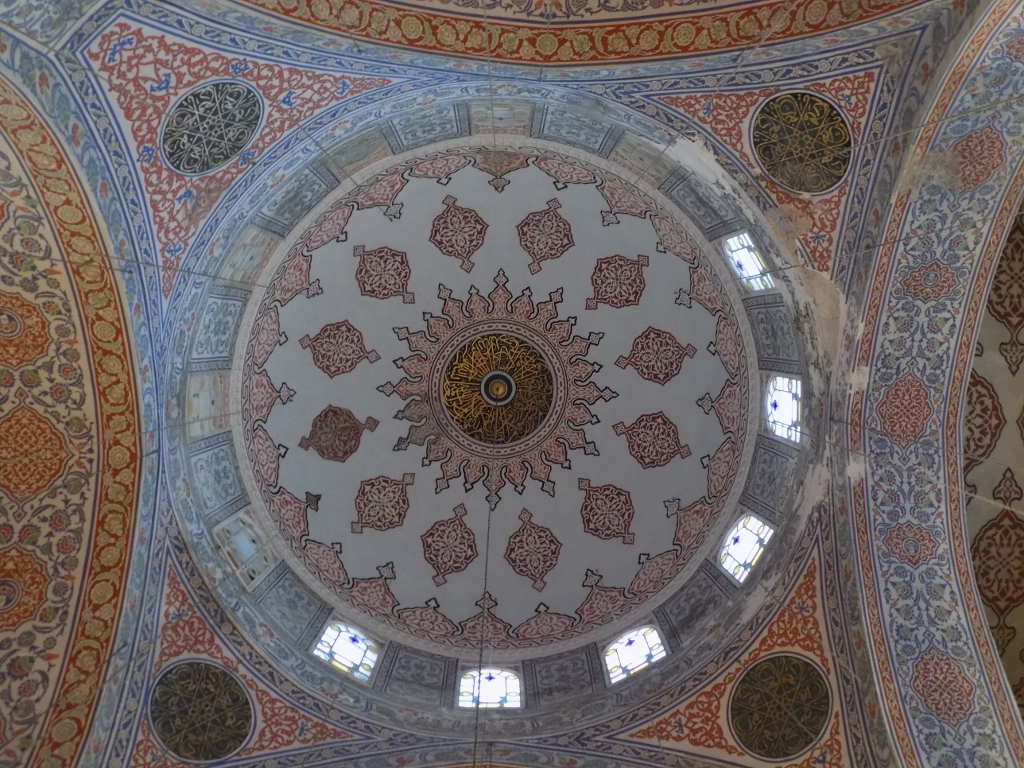 Blue Mosque, the interior
Blue Mosque, the interior
After this brief visit to the Blue Mosque, we went out and again enjoyed the view at Hagia Sophia that was lit by the Sun which at that time of the day shed wonderful light on this spectacular edifice.
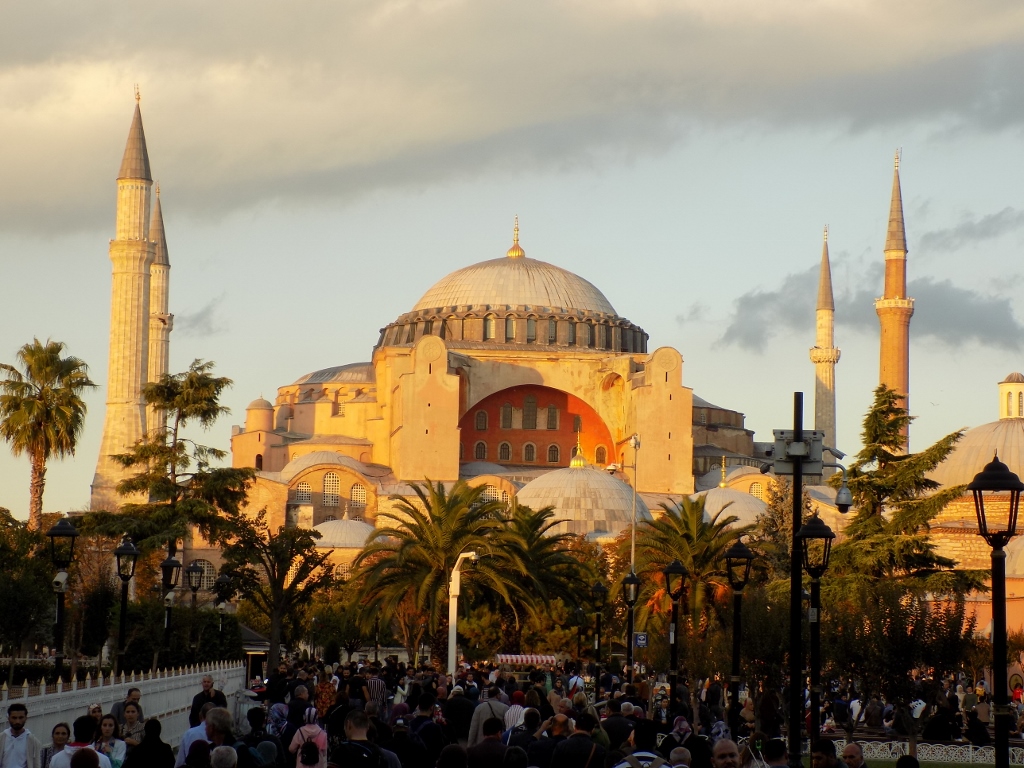 Hagia Sophia
Hagia Sophia
Then we walked slowly towards the Kapali Carsi, stopping by yet another tomb of a ruler and different officials, bought roasted maize and then went for a drink. Rather tired we returned to the hotel.
For the following day I had something completely different in mind and yet we first started with a visit to a tourist site in the very centre of the city as it was on our way, plus it was less crowded in the morning. The place was the Basilica Cistern.
This is an underground structure made at the order of the Byzantine Emperor Justinian in the first half of the 6th century. It was used to store water supply for the needs of the then palace and its surroundings. Even before the Ottoman conquest, this cistern was abandoned and neglected, and it was “discovered” again around the middle of the 16th century, only to be abandoned and neglected anew. Finally, at the end of the 20th century they restored it and in 1987 it was opened for visitors.
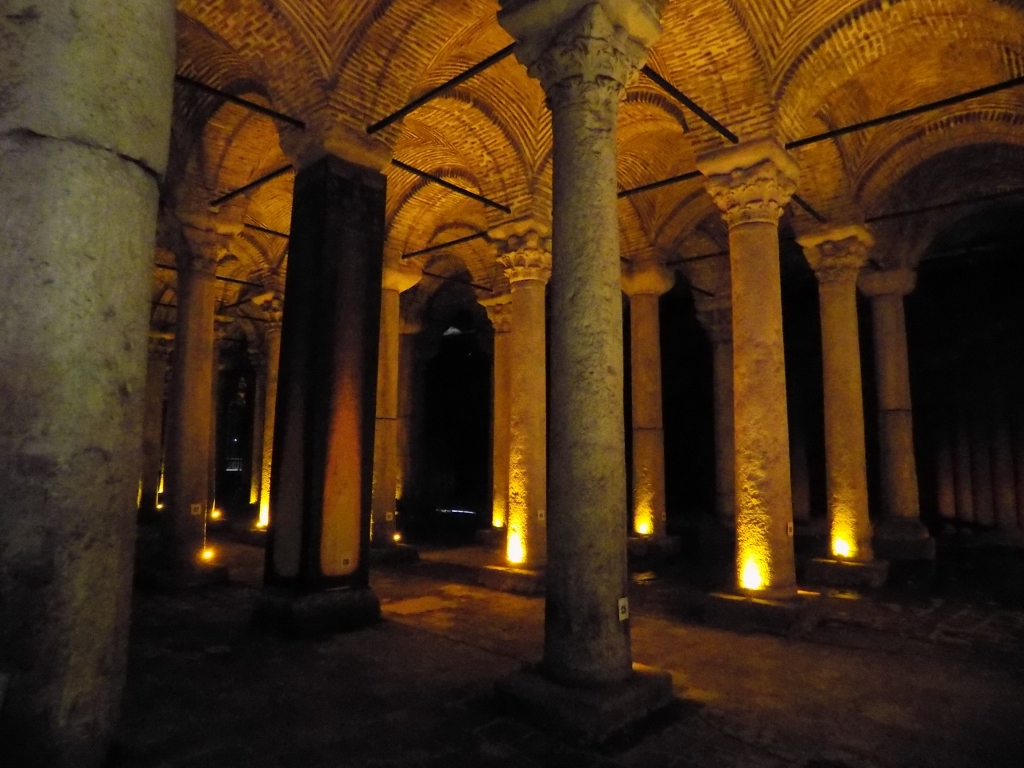 Basilica Cistern
Basilica Cistern
It got its name after a basilica that at the time when the cistern was made used to stand above this space, but this basilica is long gone. Within the cistern there are 336 columns that carry the ceiling and when it was first built the masons also used remains of former temples, so there are columns that are different from the majority of them. There is not that much to see in the cistern, other than this is an absolutely fantastic place to visit, so one should pay attention to some of these columns. One of them is known as the Column of Tears or Crying Column which always seems wet and hence the name. The legend says that this column was made as a memory of the hundreds of slaves who lost their lives during the construction of the Basilica Cistern.
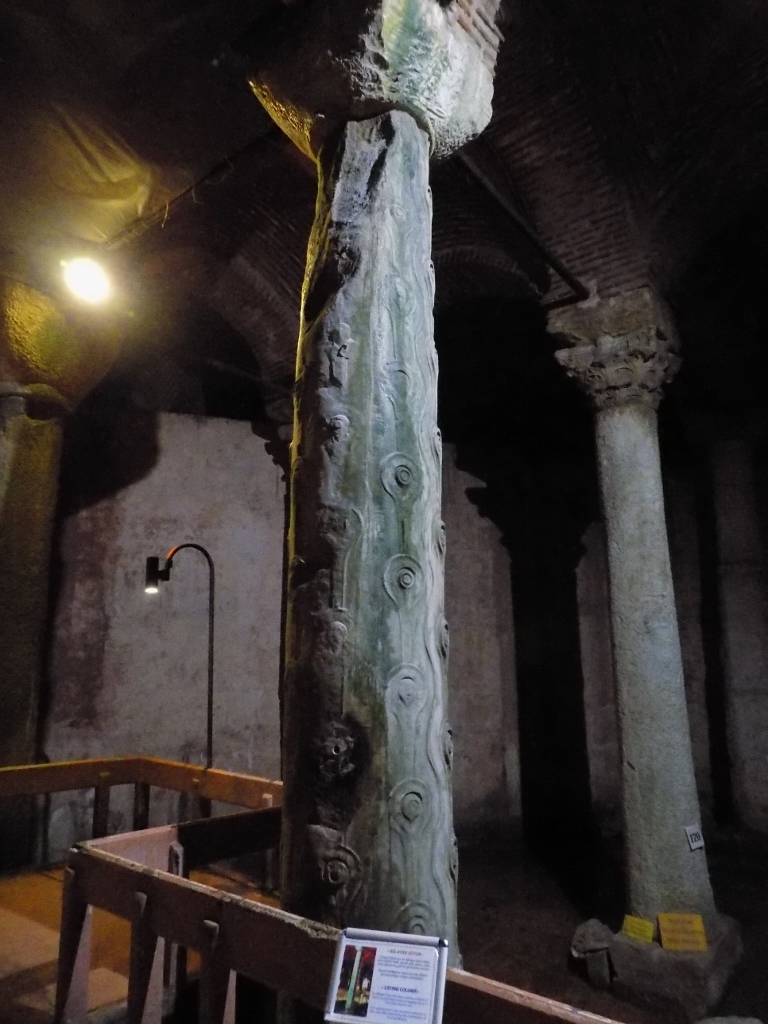 Basilica Cistern: The Column of Tears or Crying Column
Basilica Cistern: The Column of Tears or Crying Column
There are also a couple of columns in the cistern that rest on huge stones carved in the shape of Medusa’s head and the origin of these postaments is actually unknown and so is the time when they were brought here. Generally speaking, sculptures of Medusa’s head were used at the entrances into important buildings in order to safeguard those buildings since the Ancient Greek legend clearly stated that it sufficed to meet the glance of Medusa for the person to turn into a stone. Apart from being made of stone themselves, these two Medusa’s heads do not petrify anybody any more and they are placed in a rather undignified position – up-side-down and partially immersed in water.
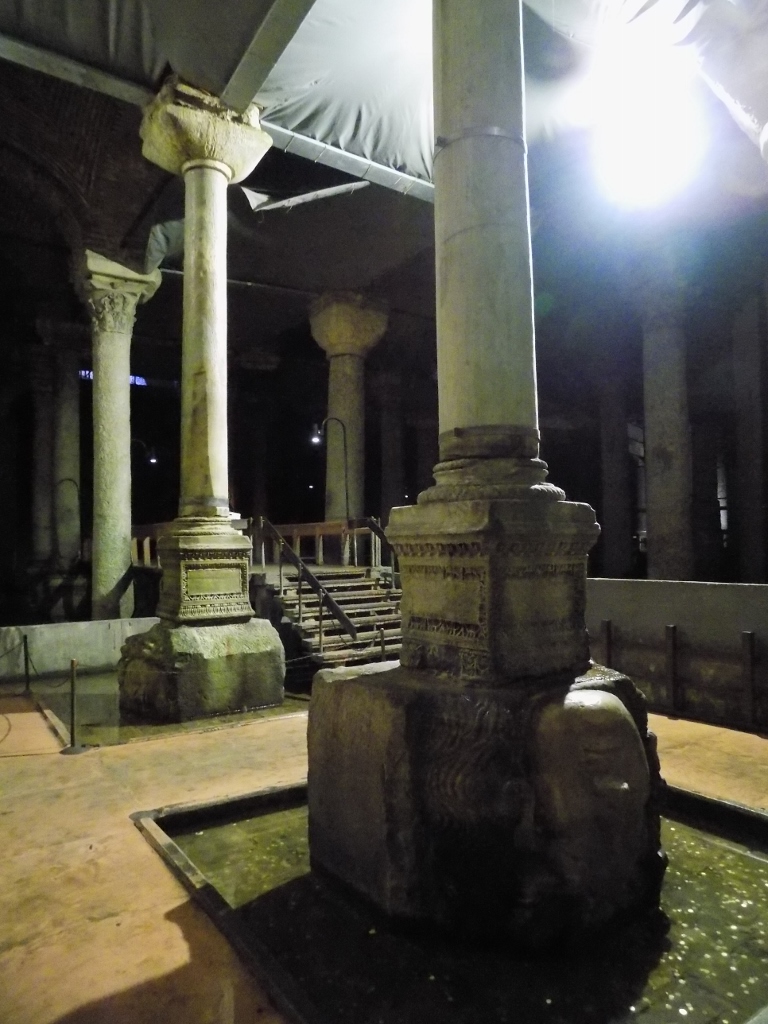 Basilica Cistern: Columns resting on Medusa’s heads
Basilica Cistern: Columns resting on Medusa’s heads
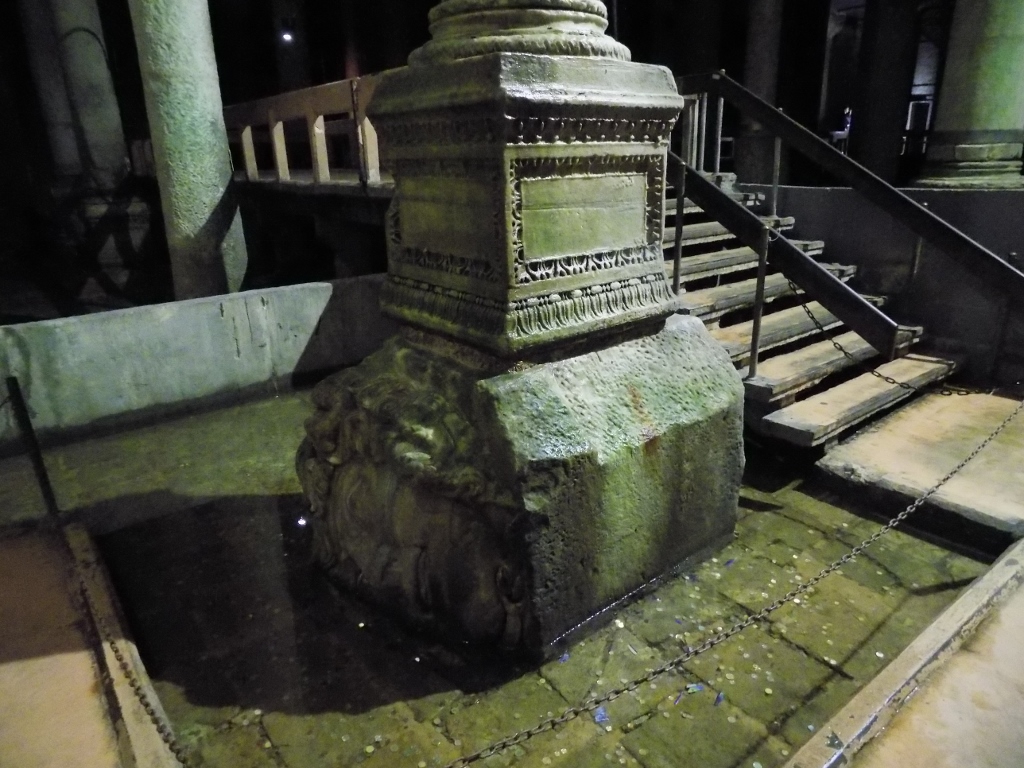 Basilica Cistern: Medusa’s head placed down on its cheek
Basilica Cistern: Medusa’s head placed down on its cheek
In practical terms, these columns with Medusa’s head were at the end of the wooden path that is installed there for the visit to the cistern and so we just turned around and went back in the direction of the exit.
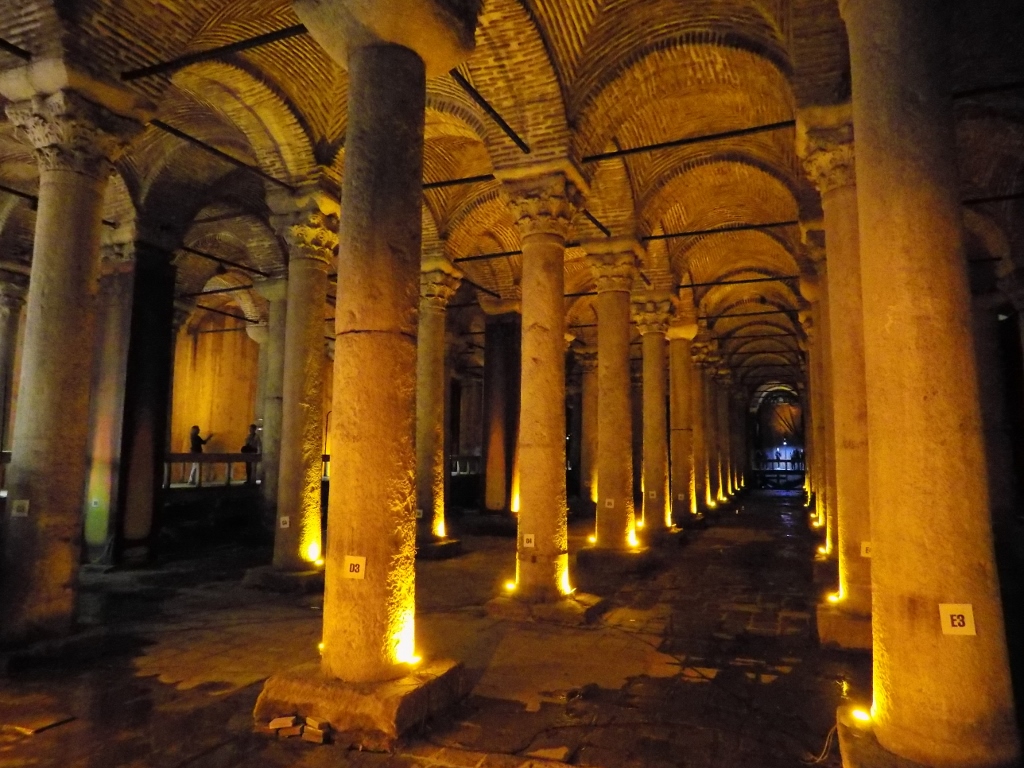 Basilica Cistern
Basilica Cistern
Once we were out in the street, we headed for an underground station where we caught a train servicing the northbound line. There we transferred to a city bus, thus reaching a place called Bahçeköy, and then after some walking we finally arrived at the desired destination. Namely, for this day I thought we could go to a forest some 25 km north of the city centre. There are picnic areas there and it is also important that there are reservoirs from which water used to be taken to the city already at the time of the Byzantium. However, the main reason why it occurred to me to come here is that the name of the place is – Belgrade Forest!
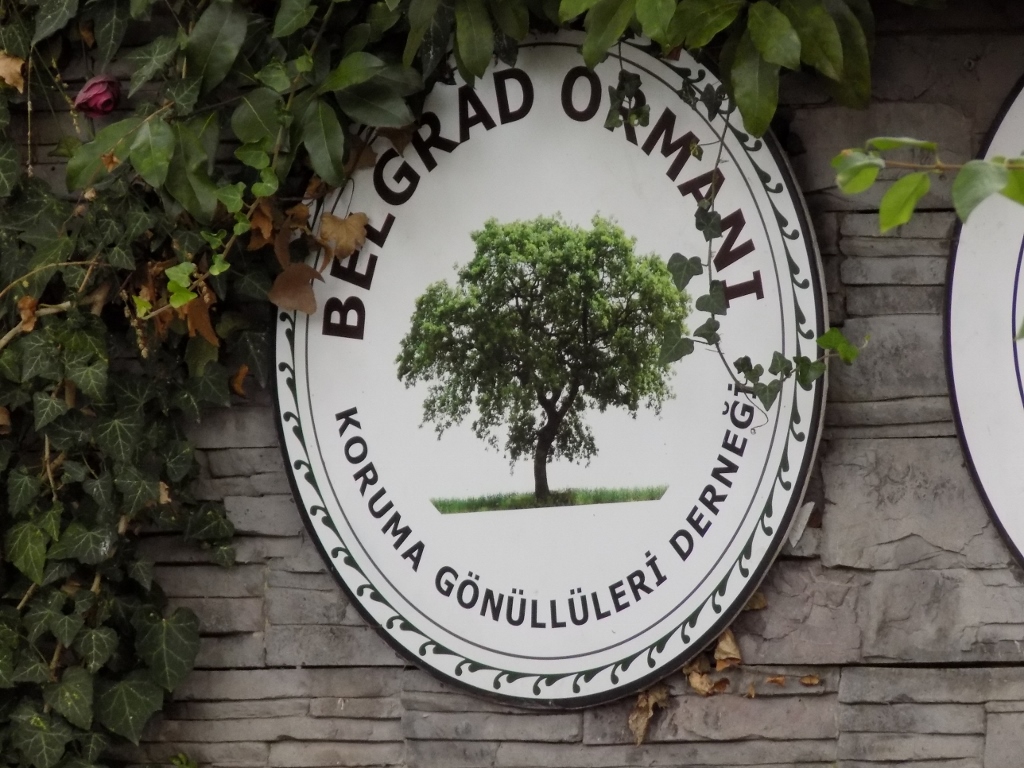 Belgrade Forest: a sign of some volunteer association for the protection
Belgrade Forest: a sign of some volunteer association for the protection
Namely, following the conquest of Belgrade, Serbia, in 1522, Sultan Suleiman the Magnificent transferred a large number of serfs from Belgrade here since apparently these Belgrade serfs were known for their waterworks skills. Be as it may, the serfs settled here and thus the forest got its name.
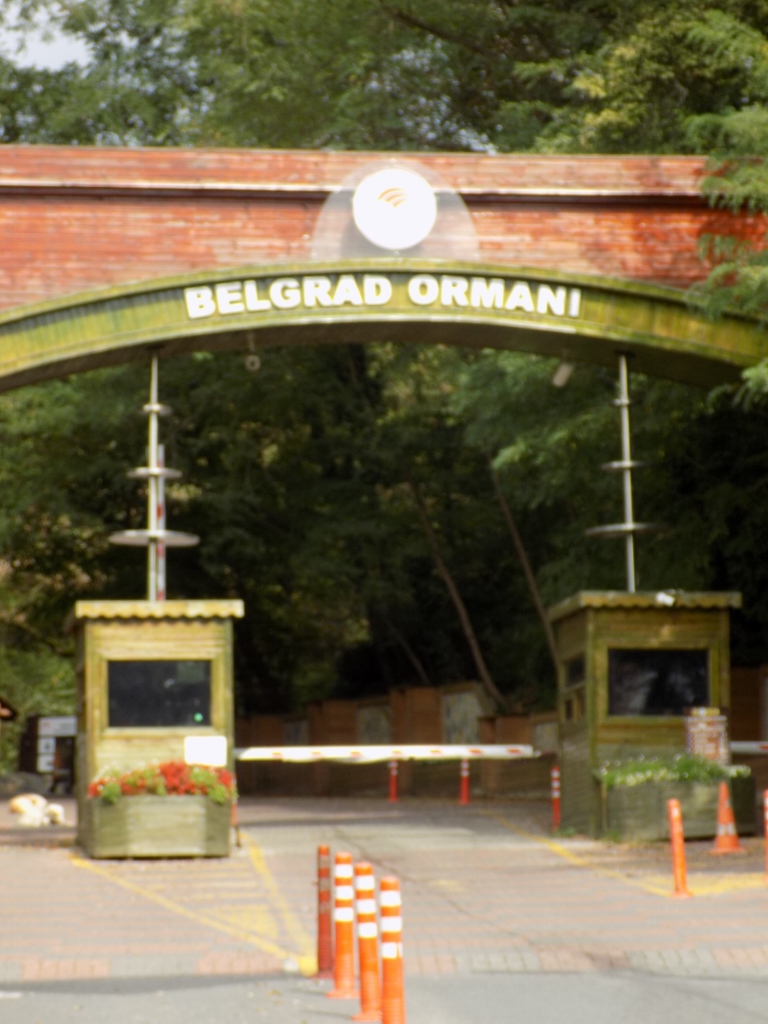 Belgrade Forest: entrance into the forest
Belgrade Forest: entrance into the forest
There are several roads and paths that one may follow here, but the two of us decided not to overdo it, rather only to walk a little to the first reservoir. Along the way we passed by a picnic area with numerous wooden tables and benches, but of course at the beginning of October there was almost nobody else around except us. The forest is much more popular during summer when everything is green and also when it offers pleasant shade in comparison to the heat of the streets of Istanbul.
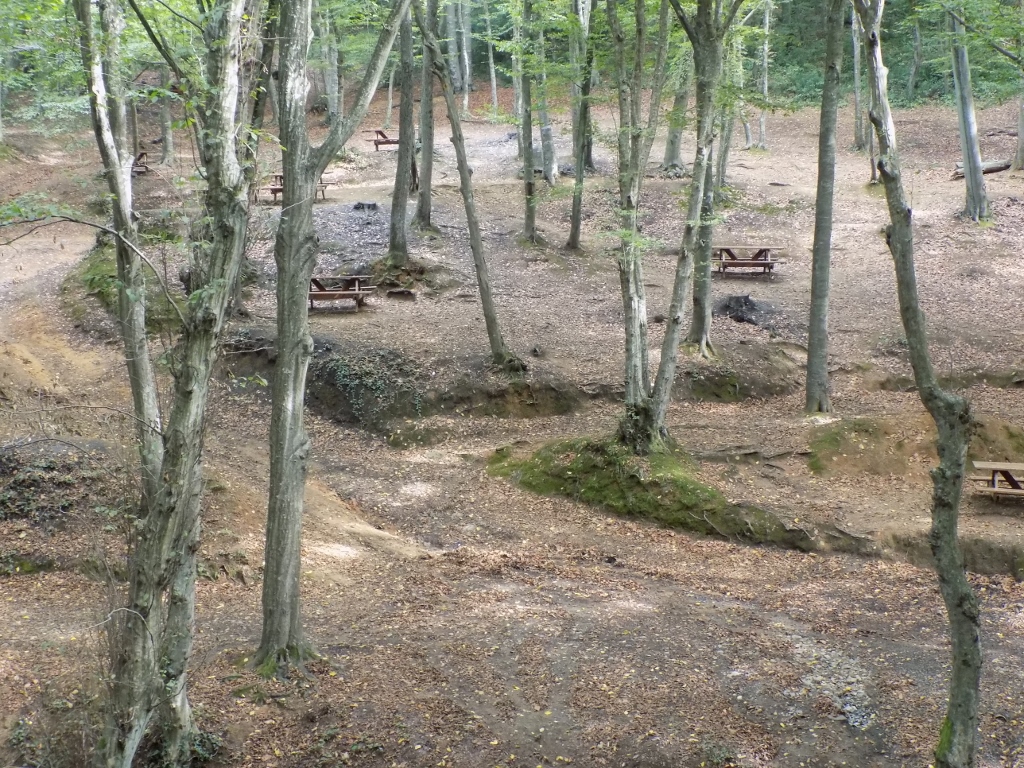 Belgrade Forest: a picnic area
Belgrade Forest: a picnic area
Then we reached one of the dams and it was possible to walk only little around it, since after all this is a dam that holds water and it is not advisable that people walk all over the place as they please.
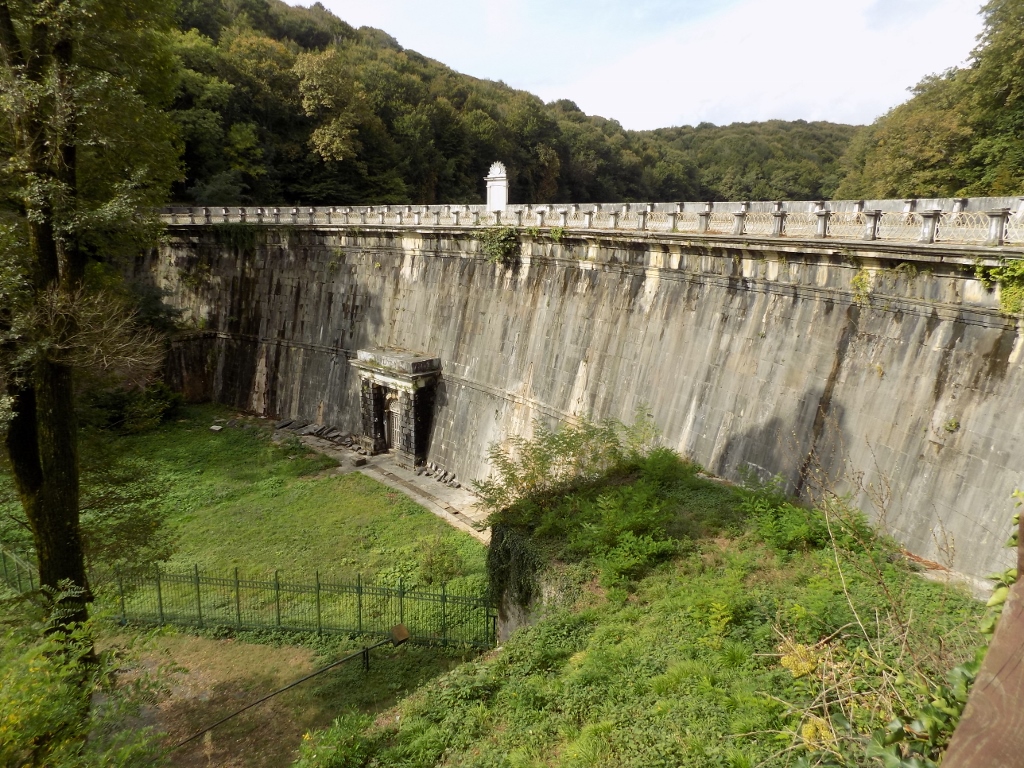 Belgrade Forest, the dam
Belgrade Forest, the dam
Admittedly, this concrete dam did not hold too much water at this time, but probably in spring, after the autumn and winter precipitation, a larger lake is formed there.
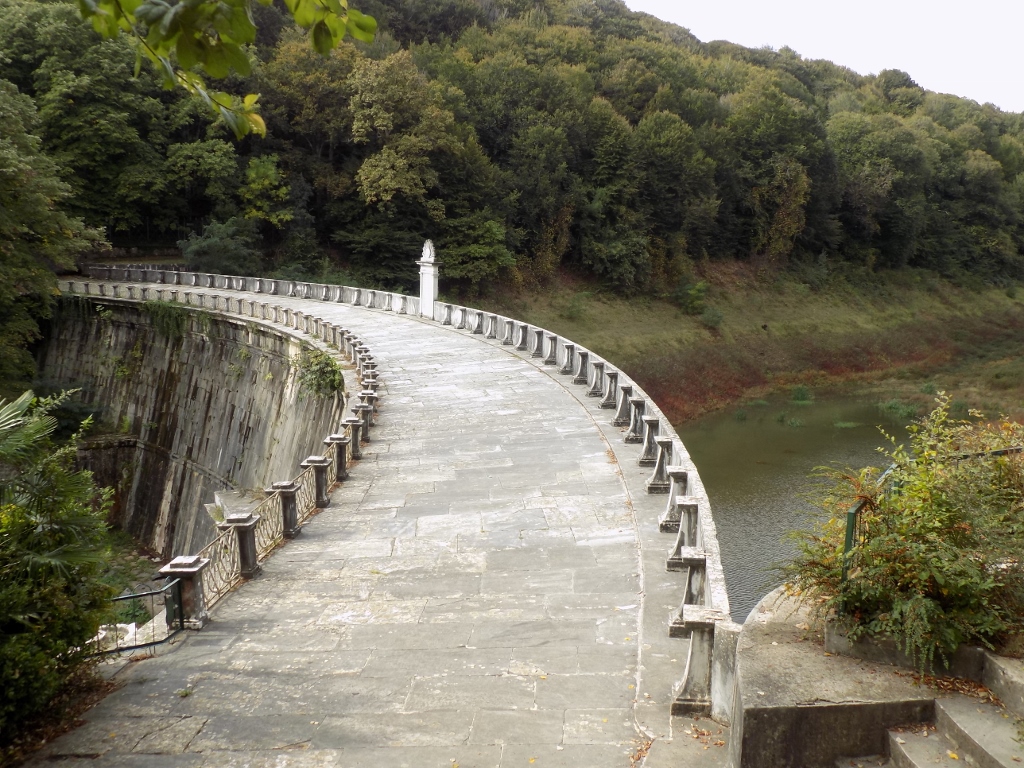 Belgrade Forest: the dam and the shallow lake behind it
Belgrade Forest: the dam and the shallow lake behind it
After this walk, we returned to Bahçeköy and sat there for a short while enjoying a coffee and then we took a bus to get to the shores of the Bosphorus, after which we took another bus in order to go more to the north to the place called Rumeli Kavağı, i.e., to the coastal part of this village.
Still, here is yet another photo from the surroundings of the forest, since on its way to the Bosphorus the bus passed beside and under an aqueduct from 1732.
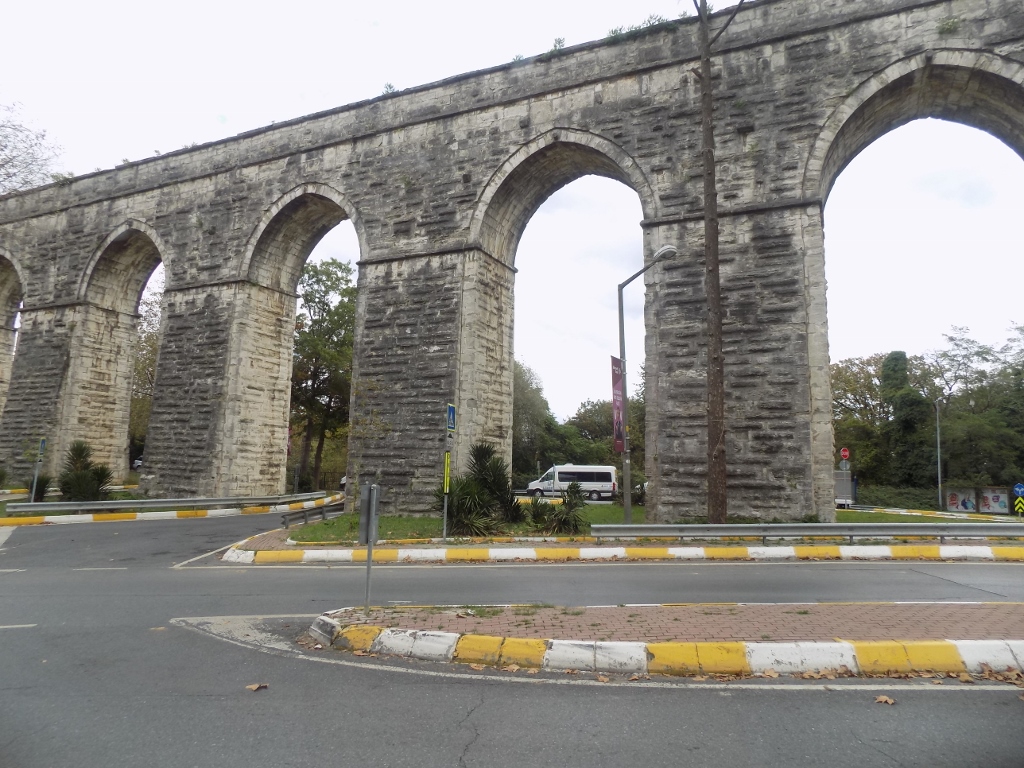 18th century aqueduct
18th century aqueduct
But, let me go to the shores of the Bosphorus with my story...

First we walked a little beside the Bosphorus and there, apparently, in addition to the more or less continuous passage of ships on their way to and from the Black Sea, people come during summer in order to bathe in the sea.
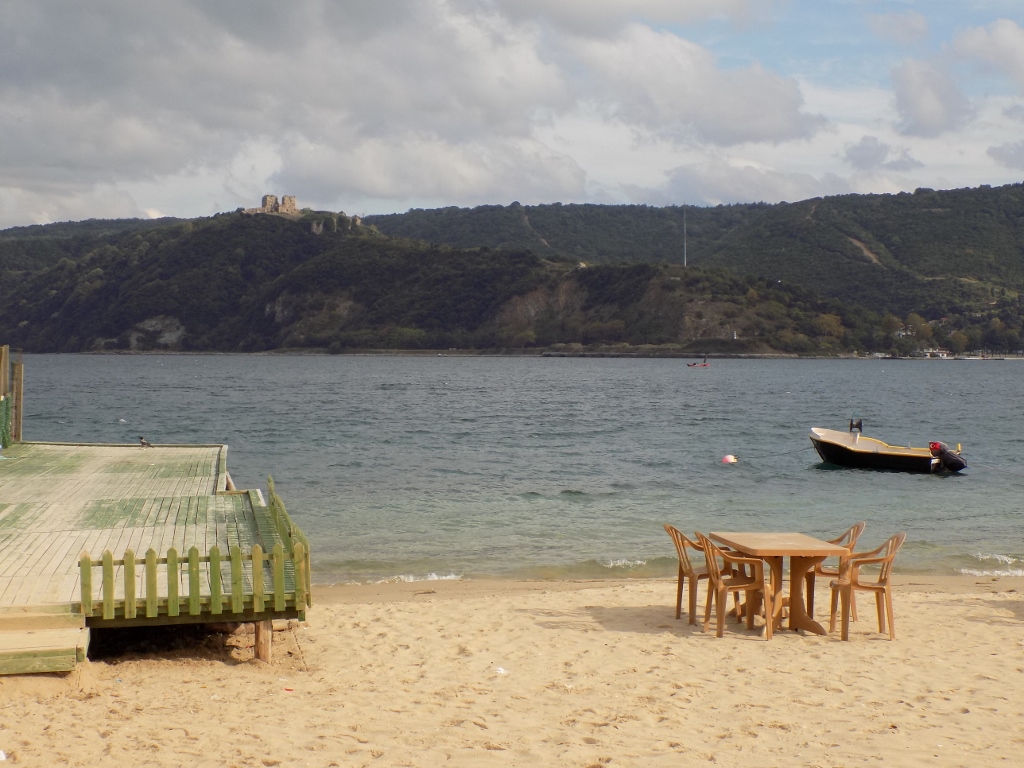 A beach at the Bosphorus during autumn
A beach at the Bosphorus during autumn
This place may also be reached by ferries that work as a part of the city transportation system and during our visit to Rumeli Kavağı village we saw off one such ferry that went down the Bosphorus from here in the direction of the centre of Istanbul.
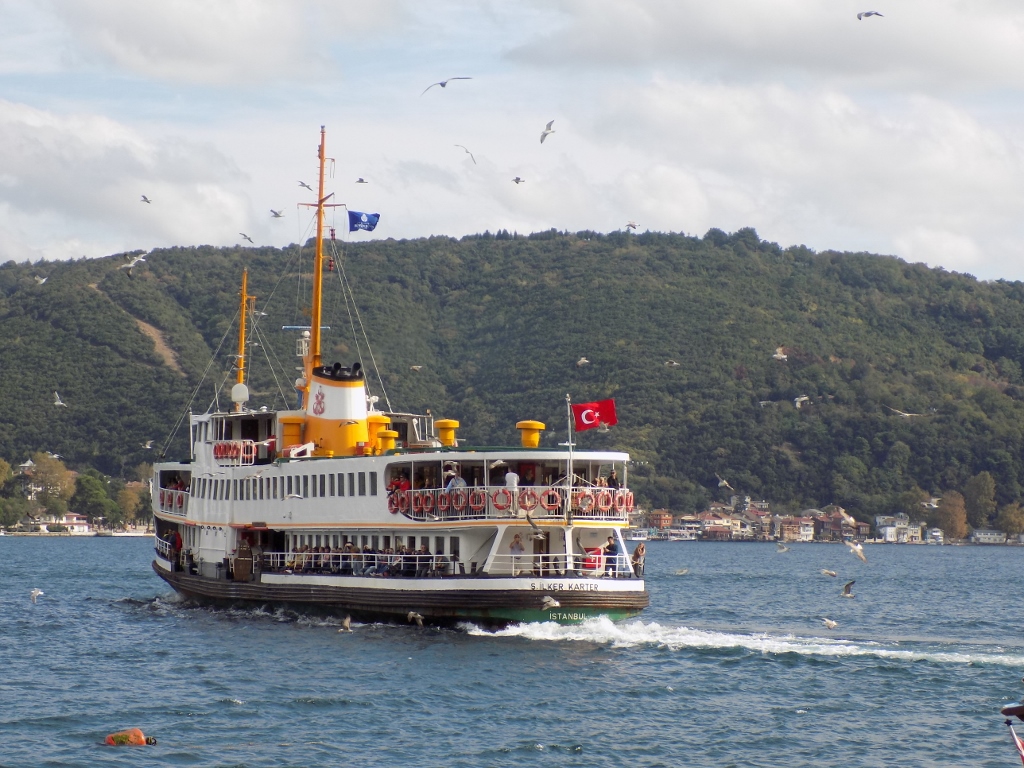 Floating city transportation
Floating city transportation
Generally speaking, both of us had the impression that the city transportation in Istanbul is fantastic and very well organised, and we were very content that already at the beginning we bought the city transportation pass which may be topped up at devices around the city and which is used for all sorts of diverse forms of public transportation.
Still, the main reason why we came here was that I had read somewhere that its specialty is – midiye – deep-fried mussels. It turned out later that this dish may be eaten throughout Istanbul, but we were not sorry in the least for coming all the way here in order to have lunch.
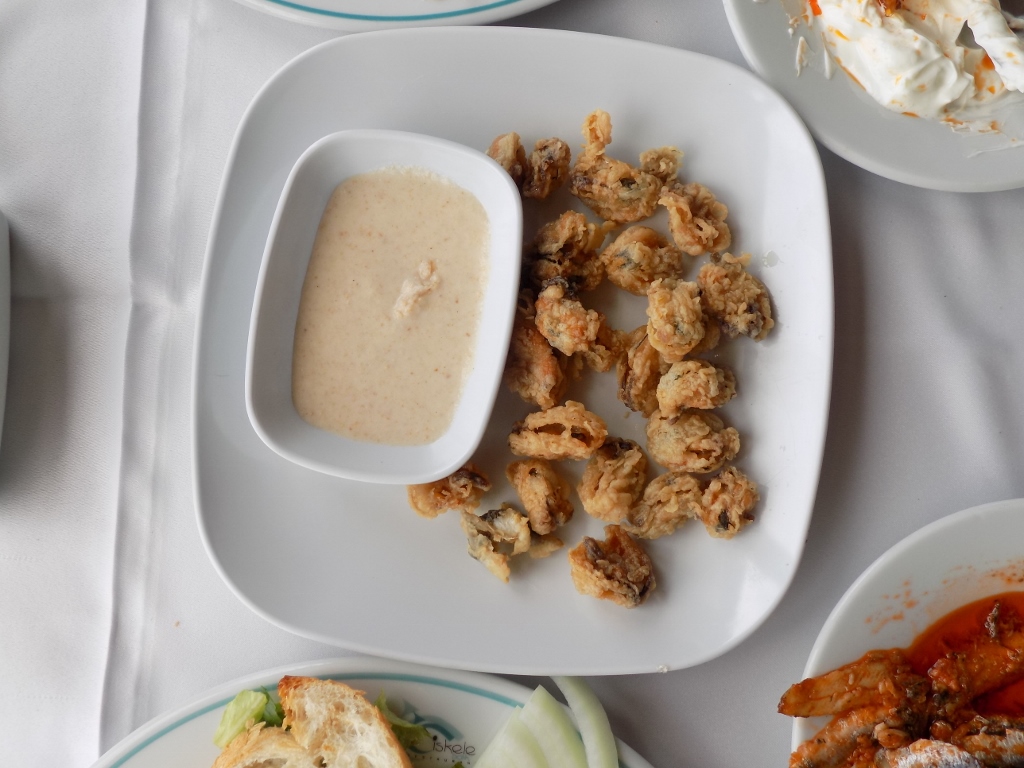 Midiye – deep-fried mussels
Midiye – deep-fried mussels
Needless to say, there were different small dishes that were served as cold starter first and since our eyes were bigger than our respective stomachs, we each took a grilled fish as well, so afterwards we were properly full.
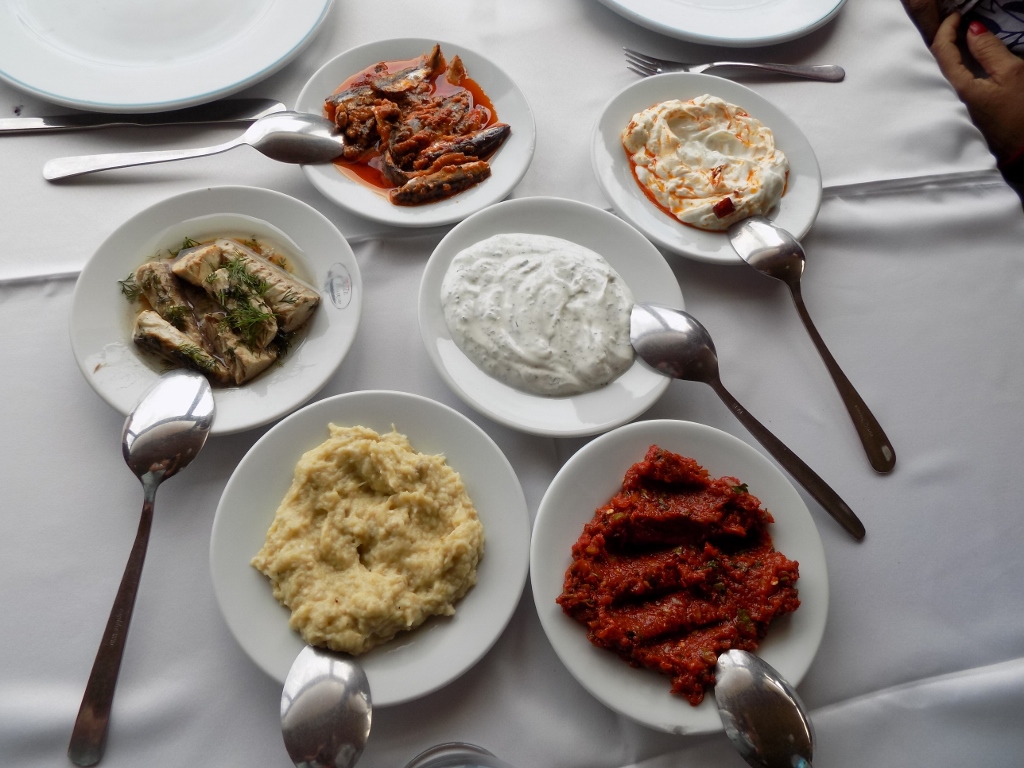 Cold starters
Cold starters
Still, in addition to excellent food, the restaurant also offered a wonderful view – at Bosphorus and the other side of the straits. On that other side there is the place called Anadolu Kavağı with its fortress and there I started to see the pattern in terms that there are several places parallel on both sides of the Bosphorus, with those on the European side being called “Rumeli,” while those on the Asian side are called “Anadolu.”
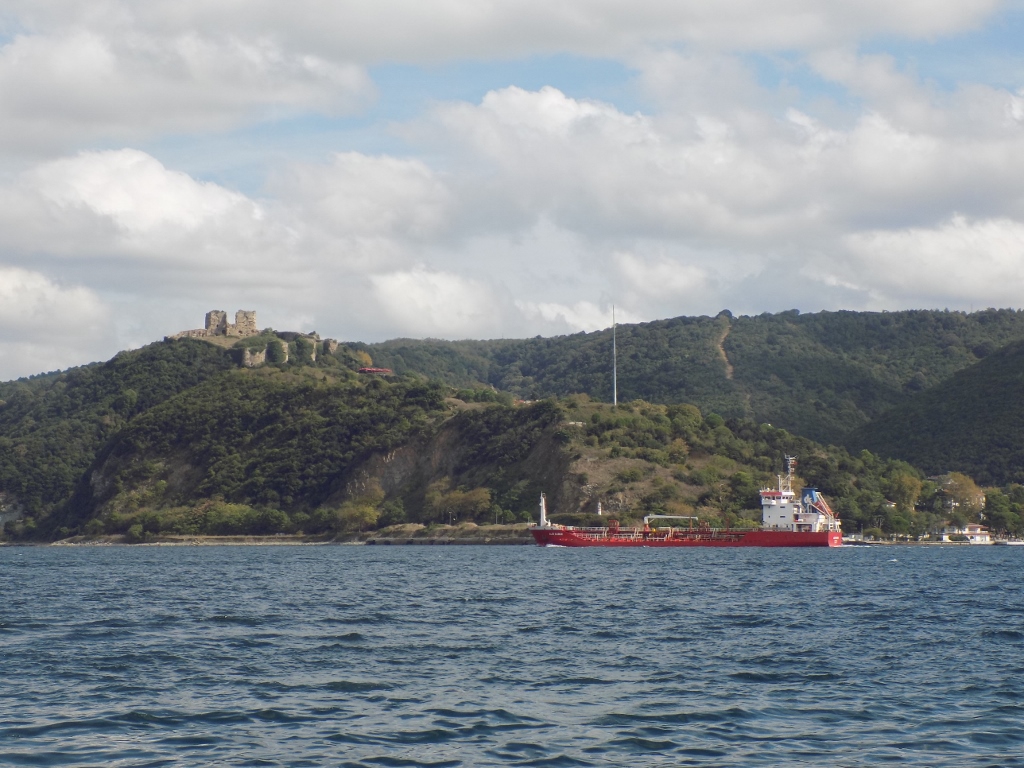 Bosphorus and Anadolu Kavağı with its fortress
Bosphorus and Anadolu Kavağı with its fortress
After the excellent and ample lunch, we walked for a little while yet and then transferred by a bus to the part of the shore close to Emirgan Park. We walked there as well admiring the Bosphorus and the sights at and around it.
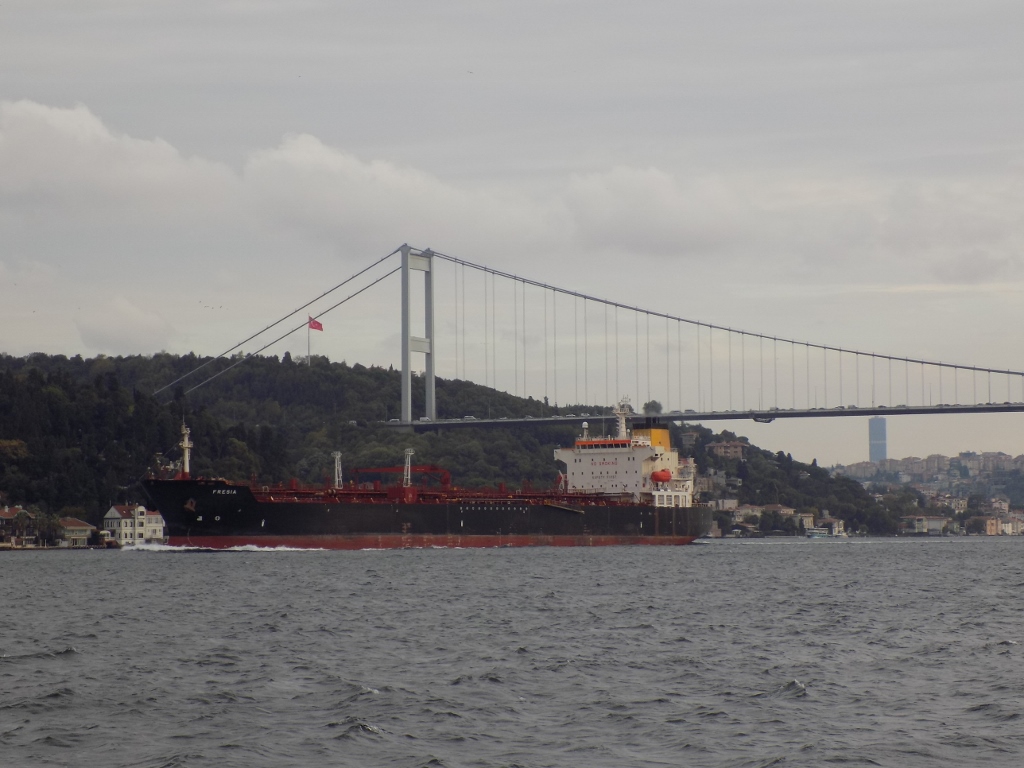 Bosphorus and the middle of the three bridges that cross it
Bosphorus and the middle of the three bridges that cross it
But, by the time we got there it was already late afternoon and the abundant lunch had already been digested to a certain degree, so it was the right time to make a break involving sweets and tea.
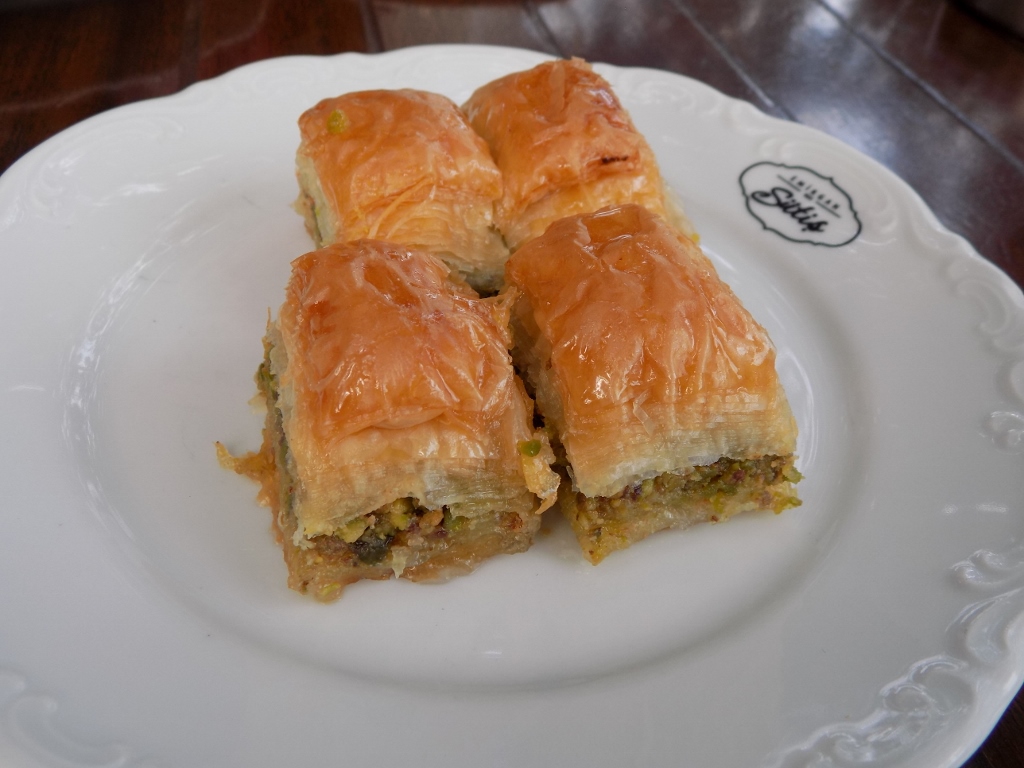 Pistachio baklavas
Pistachio baklavas
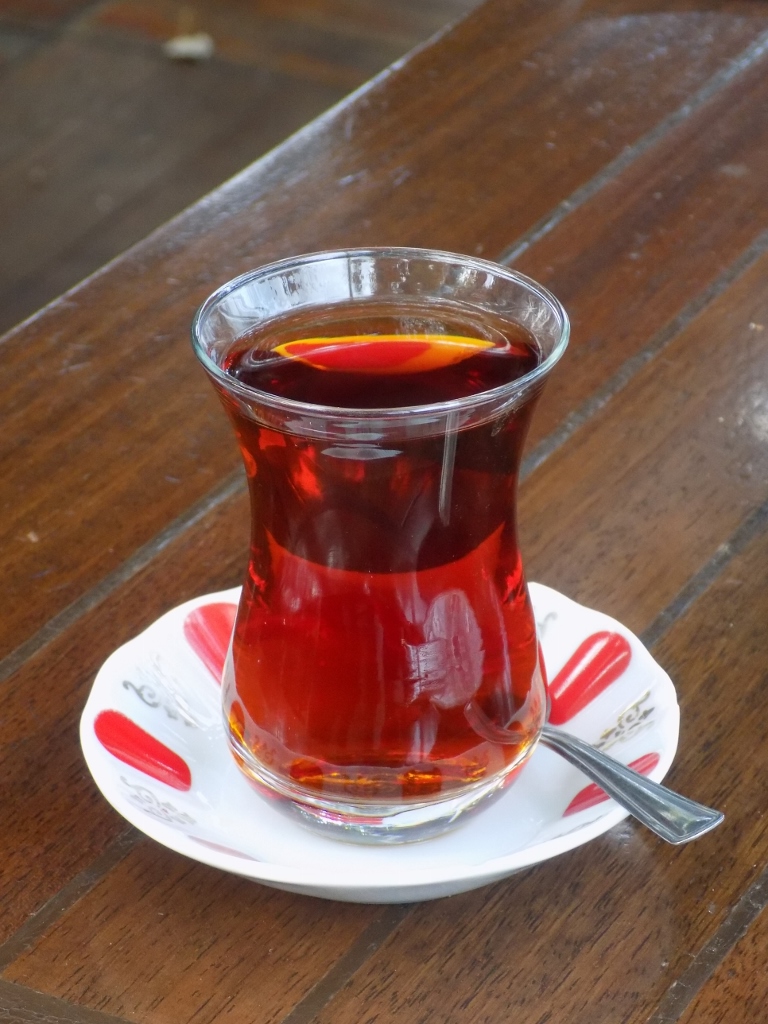 Tea traditionally served in small glasses of a specific shape
Tea traditionally served in small glasses of a specific shape
Following this pleasant respite, we caught another city bus and after a couple of more transfers we returned to the area close to our hotel. Along the way we did have an opportunity to see a part of the first bridge that spans the straits when you enter it which was very nicely lit during night.
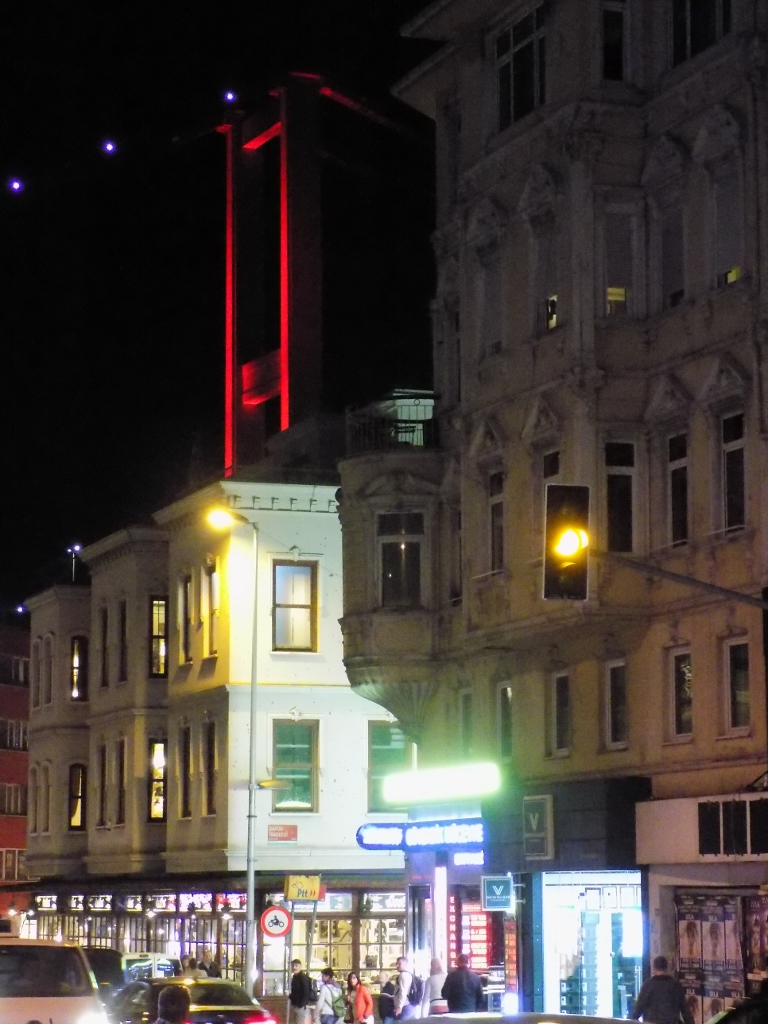 Close to the Bosphorus Bridge
Close to the Bosphorus Bridge
The next day we continued with our sightseeing of the broader centre of Istanbul. It rained that day and it was quite cloudy, but there was no way out. To start with we crossed the Beyazit Square where the main gate to Istanbul University is located.
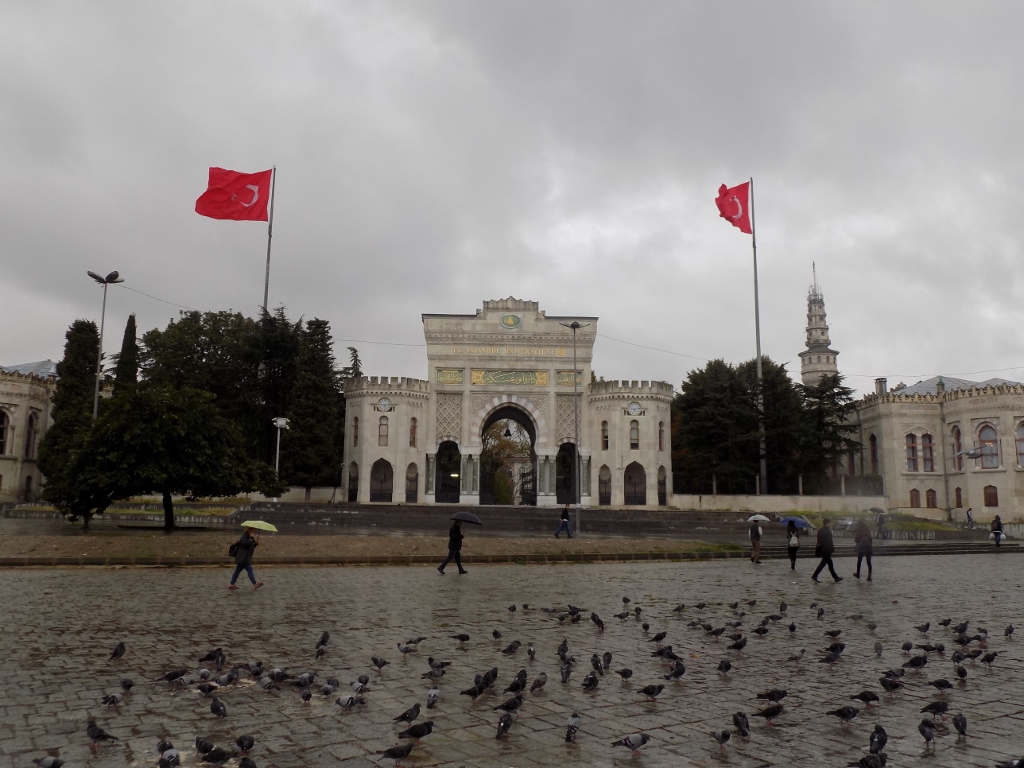 Main gate to Istanbul University
Main gate to Istanbul University
We also passed by one place where they started to prepare the kokoreç, which is a sandwich with lamb intestines. So, I have never consciously eaten anybody’s intestines, lamb’s ones included, but my very dear friend Vuk who thanks to his life’s circumstances knows Istanbul extremely well has told me that this was something not to be missed. So, I had mentally seriously prepared myself for such a gastronomic experience, but my circumstances during this stay in Istanbul would be such that I would not try this speciality after all. There, this then remains as a task for some future visit to Turkey.
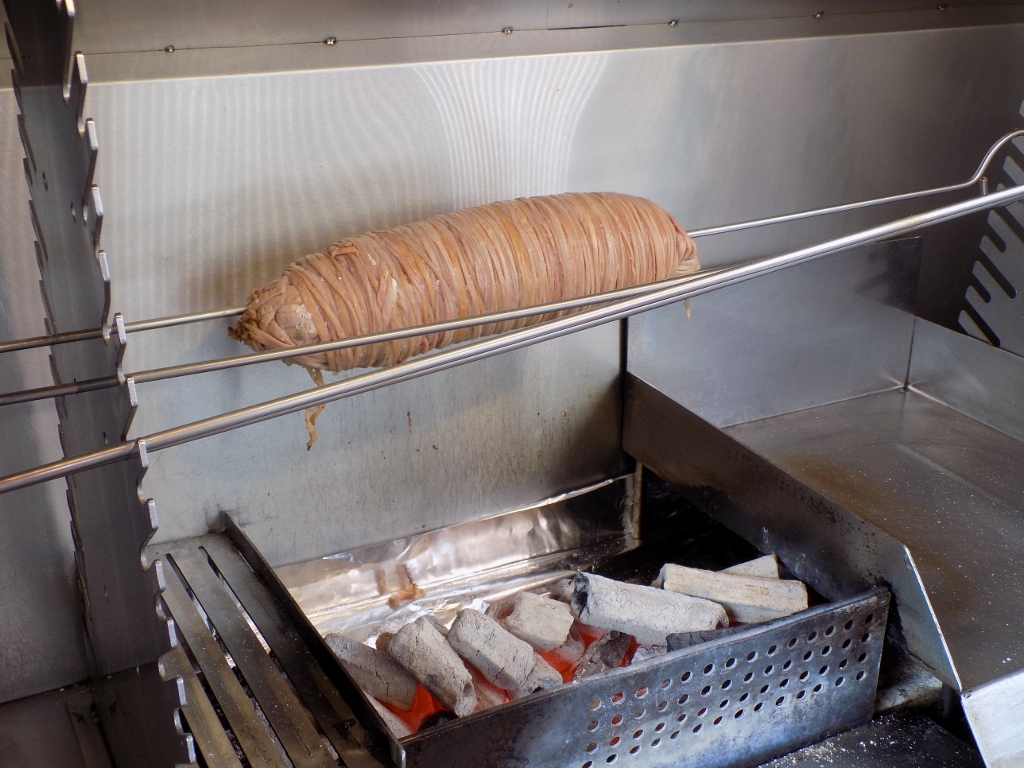 Beginning of the preparation of the kokoreç
Beginning of the preparation of the kokoreç
On this day, the two of us headed for the part of the city called Zeyrek, which surrounds a mosque of the same name, and this is one of the four areas that all together constitute a joint cultural property inscribed on the UNESCO’s World Heritage List.